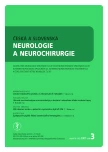Osteoplastic Decompressive Craniotomy
Authors:
J. Mraček; M. Choc; Z. Mraček
Authors‘ workplace:
Neurochirurgické oddělení FN Plzeň
Published in:
Cesk Slov Neurol N 2007; 70/103(3): 290-293
Category:
Short Communication
Overview
Decompressive craniotomy belongs to standard neurosurgical interventions in the therapy for the brain oedema. Decompression is usually carried out by osteoclastic decompressive craniotomy (craniectomy) followed later by necessary plasty of the bone defect. In the case of osteoplastic decompressive craniotomy a free bone plate elevated by the cerebral tissue expansion is left in place. After the oedema disappearance, the bone plate returns to its original position and is reattached. Therefore, cranioplasty need not be performed. There was analysed a ten-years´ set of 129 patients who had undergone osteoplastic decompressive craniotomy for the brain oedema under various pathological conditions (98× trauma, 22× vascular lesion, 8× tumor, 1× abscess). The patients´ outcome was evaluated using Karnovsky performance scale (more than 70–39%, 30–70–26%, less than 30–35%) and Glasgow outcome scale (5–19%, 4–20%, 3–26%, 2–13%, 1–22%). Osteoplastic decompressive craniotomy is an effective method of treating the brain oedema when the degree of expansion does not require a radical removal of the bone plate and, thus, further surgery – the bone defect plasty – is not needed.
Key words:
osteoplastic decompressive craniotomy – decompressive craniectomy – intracranial hypertension – brain oedema – cranioplasty
Sources
1. Mraček Z. Význam veliké dekompresivní kraniotomie při edému mozku u těžkých kraniocerebrálních poranění. Rozhl v chir 1977; 56: 597-605.
2. Mraček Z. Význam dekompresivní kraniotomie u akutní okluze arteria cerebri media s kmenovou symptomatologií způsobenou tlakem edematózní mozkové hemisféry. Cesk Slov Neurol N 1978; 41/74: 390-4.
3. Mraček Z. Idea dekompresivní kraniotomie. Plzeň Lék Sborn 2000; 74 (Suppl): 195-9.
4. Grady MS. Decompressive craniectomy. J Neurosurg 2006; 104: 467-8.
5. Arabi B, Hesdorffer DC, Ahn ES, Aresco C, Scalea TM, Eisenberg HM. Outcome following decompressive craniectomy for malignant swelling due to severe head injury. J Neurosurg 2006; 104: 469-79.
6. Bullock R, Chesnut RM, Clinton G, Ghajar J, Marion DW, Narayan RK et al. Guidelines for the management of severe head injury. Brain Trauma Foundation. Eur J Emerg Med 1996; 3: 109-27.
7. Tokoro K, Chiba Y, Tsubone K. Late infection after cranioplasty – review of 14 cases. Neurol Med Chir 1989; 29: 196-201.
8. Khoo JCM. Replacement of a self-adjusting bone flap. J Neurosurg 1976; 45:589-91.
9. Mollman HD, Haines SJ. Risk factors for postoperative neurosurgical wound infection. A case-control study. J Neurosurg 1968; 64: 902-6.
10. Choc M, Runt V, Navratil L, Skuci I, Mracek J. Indications to decompressive craniotomy. 12th European Congress of Neurosurgery (EANS); 2003 Sept 7-12; Lisabon, Portugal. Monduzzi editore 2003: 627-30.
11. Choc M, Mracek J. Osteoplastic decompressive craniotomy. 12th European Congress of Neurosurgery (EANS); 2003 Sept 7-12; Lisbon, Portugal. Monduzzi editore: 2003: 667-71.
Labels
Paediatric neurology Neurosurgery NeurologyArticle was published in
Czech and Slovak Neurology and Neurosurgery

2007 Issue 3
- Metamizole vs. Tramadol in Postoperative Analgesia
- Memantine in Dementia Therapy – Current Findings and Possible Future Applications
- Memantine Eases Daily Life for Patients and Caregivers
- Metamizole at a Glance and in Practice – Effective Non-Opioid Analgesic for All Ages
- Advances in the Treatment of Myasthenia Gravis on the Horizon
Most read in this issue
- Chiari Malformation: Own Experience
- Osmotic Demyelination Syndrome – MRI Diagnosis: a Case Report
- The Brain MR Imaging in Patients with Myotonic Dystrophy DM 1
- Osteoplastic Decompressive Craniotomy
